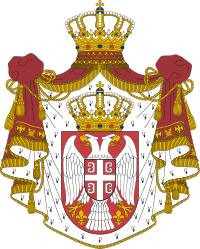
Back شعار صربيا Arabic شعار صربيا ARZ Serbiya gerbi Azerbaijani Герб Сербіі Byelorussian Герб Сэрбіі BE-X-OLD Герб на Сърбия Bulgarian সার্বিয়ার চিনত্হান BPY Grb Srbije BS Escut de Sèrbia Catalan Státní znak Srbska Czech
| Coat of arms of Serbia | |
|---|---|
 Greater version | |
| Versions | |
 Lesser version | |
| Armiger | Republic of Serbia |
| Adopted | 1882 2004 (readopted) 2010 (standardized) |
| Shield | Gules, between two fleurs-de-lys in base Or, a double-headed eagle displayed inverted Argent, armed, beaked and langued Or, surmounted by an escutcheon Gules thereon a cross between four firesteels Argent |
| Other elements | The shield is ensigned with a crown Or. The whole is within a mantle Gules fringed and tasselled Or, lined ermine and crowned Or |
| Use | Governmental |
The coat of arms of the Republic of Serbia (Serbian: грб Републике Србије, romanized: grb Republike Srbije) consists of two main heraldic symbols which represent the identity of the Serbian state and Serbian people across the centuries: the Serbian eagle (a silver double-headed eagle adopted from the Nemanjić dynasty) and the Serbian cross (or cross with firesteels).[1][2] The coat of arms also features the Serbian historical crown; while unusual for republics, it is not unprecedented, as can be seen in coat of arms of numerous European countries with republican form of government (Russia, Poland, Romania, Hungary, Bulgaria, Montenegro, and San Marino). However, Serbia's coat of arms still retains strong monarchist elements absent from the other republics, including the mantle and pavillon found in the greater coat of arms of some modern and many historical monarchies.
The coat of arms is used in the form of the greater coat of arms (Велики грб / Veliki grb) and lesser coat of arms (Мали грб / Mali grb), as provided by the Article 7 of the Constitution of Serbia.
- ^ "Закон о изгледу и употреби грба, заставе и химне Републике Србије: 36/2009-3" [Law on the appearance and use of the coat of arms, flag and anthem of the Republic of Serbia: 36 / 2009-3] (in Serbian). Pravno informacioni sistem Republike Srbije. 15 May 2009. Retrieved 13 June 2021.
- ^ "National Symbols and Anthem of the Republic of Serbia". Embassy of the Republic of Serbia in Great Britain. Retrieved 26 July 2018.